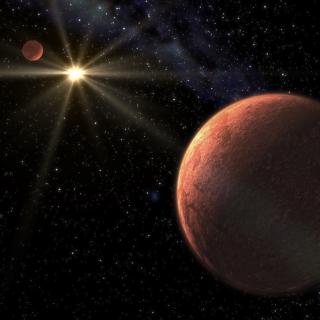Fuhrmeister, B.; Czesla, S.; Schmitt, J. H. M. M.; Jeffers, S. V.; Caballero, J. A.; Zechmeister, M.; Reiners, A.; Ribas, I.; Amado, P. J.; Quirrenbach, A.; Béjar, V. J. S.; Galadí-Enríquez, D.; Guenther, E. W.; Kürster, M.; Montes, D.; Seifert, W.
Bibliographical reference
Astronomy and Astrophysics, Volume 615, id.A14, 25 pp.
Advertised on:
7
2018
Journal
Citations
79
Refereed citations
65
Description
Stellar activity is ubiquitously encountered in M dwarfs and often
characterised by the Hα line. In the most active M dwarfs,
Hα is found in emission, sometimes with a complex line profile.
Previous studies have reported extended wings and asymmetries in the
Hα line during flares. We used a total of 473 high-resolution
spectra of 28 active M dwarfs obtained by the CARMENES (Calar Alto
high-Resolution search for M dwarfs with Exo-Earths with Near-infrared
and optical Echelle Spectrographs) spectrograph to study the occurrence
of broadened and asymmetric Hα line profiles and their association
with flares, and examine possible physical explanations. We detected a
total of 41 flares and 67 broad, potentially asymmetric, wings in
Hα. The broadened Hα lines display a variety of profiles
with symmetric cases and both red and blue asymmetries. Although some of
these line profiles are found during flares, the majority are at least
not obviously associated with flaring. We propose a mechanism similar to
coronal rain or chromospheric downward condensations as a cause for the
observed red asymmetries; the symmetric cases may also be caused by
Stark broadening. We suggest that blue asymmetries are associated with
rising material, and our results are consistent with a prevalence of
blue asymmetries during the flare onset. Besides the Hα
asymmetries, we find some cases of additional line asymmetries in He I
D3, Na I D lines, and the He I line at 10 830 Å taken
all simultaneously thanks to the large wavelength coverage of CARMENES.
Our study shows that asymmetric Hα lines are a rather common
phenomenon in M dwarfs and need to be studied in more detail to obtain a
better understanding of the atmospheric dynamics in these objects.
Related projects

Very Low Mass Stars, Brown Dwarfs and Planets
Our goal is to study the processes that lead to the formation of low mass stars, brown dwarfs and planets and to characterize the physical properties of these objects in various evolutionary stages. Low mass stars and brown dwarfs are likely the most numerous type of objects in our Galaxy but due to their low intrinsic luminosity they are not so
Rafael
Rebolo López

Exoplanets and Astrobiology
The search for life in the universe has been driven by recent discoveries of planets around other stars (known as exoplanets), becoming one of the most active fields in modern astrophysics. The growing number of new exoplanets discovered in recent years and the recent advance on the study of their atmospheres are not only providing new valuable
Enric
Pallé Bago